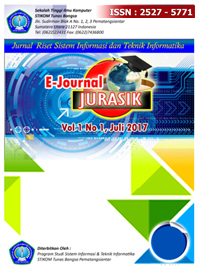Penerapan Algoritma K-Means dalam Mengkluster Persentase Rumah Tangga yang Memiliki Komputer Berdasarkan Provinsi
Abstract
Full Text:
PDFReferences
L. Maulida, “KUNJUNGAN WISATAWAN KE OBJEK WISATA UNGGULAN DI PROV . DKI JAKARTA DENGAN K-MEANS,” JISKa (Jurnal Informatika Sunan Kalijaga), vol. 2, no. 3, pp. 167–174, 2018.
ASRONI and R. ADRIAN, “Penerapan Metode K-Means Untuk Clustering Mahasiswa Berdasarkan Nilai Akademik Dengan Weka Interface Studi Kasus Pada Jurusan Teknik Informatika UMM Magelang,” JURNAL ILMIAH SEMESTA TEKNIKA, vol. 18, no. 1, pp. 76–82, 2015.
I. Parlina, A. P. Windarto, A. Wanto, and M. R. Lubis, “Memanfaatkan Algoritma K-Means dalam Menentukan Pegawai yang Layak Mengikuti Asessment Center untuk Clustering Program SDP,” CESS (Journal of Computer Engineering System and Science), vol. 3, no. 1, pp. 87–93, 2018.
S. Sudirman, A. P. Windarto, and A. Wanto, “Data Mining Tools | RapidMiner : K-Means Method on Clustering of Rice Crops by Province as Efforts to Stabilize Food Crops In Indonesia,” IOP Conference Series: Materials Science and Engineering, vol. 420, no. 12089, pp. 1–8, 2018.
R. W. Sari, A. Wanto, and A. P. Windarto, “Implementasi Rapidminer dengan Metode K-Means (Study Kasus : Imunisasi Campak pada Balita Berdasarkan Provinsi),” KOMIK (Konferensi Nasional Teknologi Informasi dan Komputer), vol. 2, no. 1, pp. 224–230, 2018.
M. G. Sadewo, A. P. Windarto, and A. Wanto, “Penerapan Algoritma Clustering dalam Mengelompokkan Banyaknya Desa/Kelurahan Menurut Upaya Antisipasi/ Mitigasi Bencana Alam Menurut Provinsi dengan K-Means,” KOMIK (Konferensi Nasional Teknologi Informasi dan Komputer), vol. 2, no. 1, pp. 311–319, 2018.
F. Nasari and C. J. M. Sianturi, “Penerapan Algoritma K-Means Clustering Untuk Pengelompokkan Penyebaran Diare Di Kabupaten Langkat,” Cogito Smart Journal, vol. 2, no. 2, pp. 108–119, 2016.
Y. Darmi and A. Setiawan, “PENERAPAN METODE CLUSTERING K-MEANS DALAM,” Jurnal Media Infotama Vol., vol. 12, no. 2, pp. 148–157, 2016.
Y. R. Nasution and M. Eka, “PENERAPAN ALGORITMA K-MEANS CLUSTERING PADA APLIKASI,” Jurnal Ilmu Komputer dan Informatika, vol. 2, no. 1, pp. 77–88, 2018.
DOI: http://dx.doi.org/10.30645/senaris.v1i0.60
Refbacks
- There are currently no refbacks.
 








